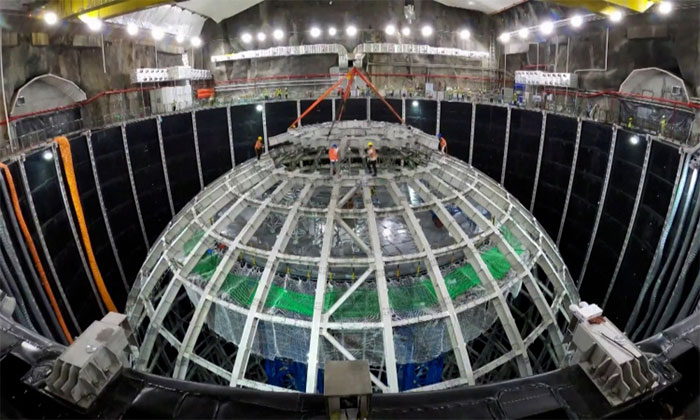On June 24, China completed the main structure of the Jiangmen Underground Neutrino Observatory (JUNO) in Guangdong Province, southern China.

The Jiangmen Underground Neutrino Observatory is under construction.
The main structure consists of a massive spherical stainless steel grid that will support the core equipment of JUNO—a spherical detector equivalent to a 13-story building, covered by 20,000 photomultiplier tubes and filled with 20,000 tons of a specially formulated liquid.
The entire structure is being built at the center of a water tank located beneath a large cave in the city of Jiangmen. Engineers will use a lifting platform to install the acrylic sphere layer by layer from the top down inside the steel grid. At the same time, the photomultiplier tubes and other components will also be attached to the steel grid. Once completed, the acrylic sphere will be filled with a liquid capable of producing flickering light, while the water tank will cover the entire detector to protect it from natural radiation emitted by the surrounding rocks.
Neutrinos, often referred to as “ghost particles”, are elementary particles with an extremely small mass, so small that they were once thought to be massless. They are the second most abundant particles in the universe after photons (light particles).
When neutrinos pass through the detector, a tiny fraction of them will interact with the liquid, producing flickering light that is detected by the photomultiplier tubes as neutrino signals for further calculation and study. In addition to neutrinos from nuclear reactors, JUNO will also study neutrinos from supernovae, the Sun, the Earth, and our atmosphere.
The JUNO Observatory is operated by the Institute of High Energy Physics of the Chinese Academy of Sciences. Its power supply comes from the Yangjiang and Taishan nuclear power plants, both located over 50 kilometers away.
This ghost particle detector, valued at approximately $305.3 million, is expected to be completed and operational by 2023, becoming the second largest neutrino experiment facility in China. It is designed to detect and measure the properties of neutrinos with unprecedented accuracy and resolution, helping scientists gain a deeper understanding of their mass, how they can change identity during oscillation, and solving many mysteries surrounding this fundamental yet elusive particle.
Video: Reuters


















































